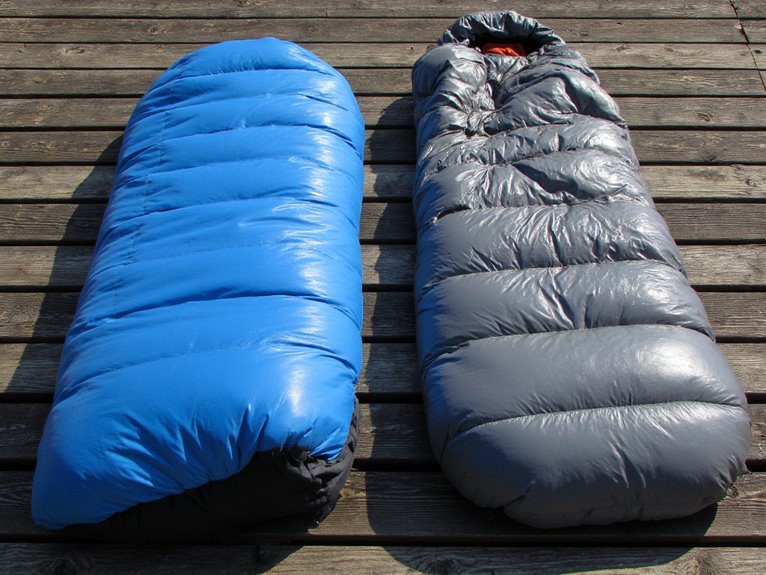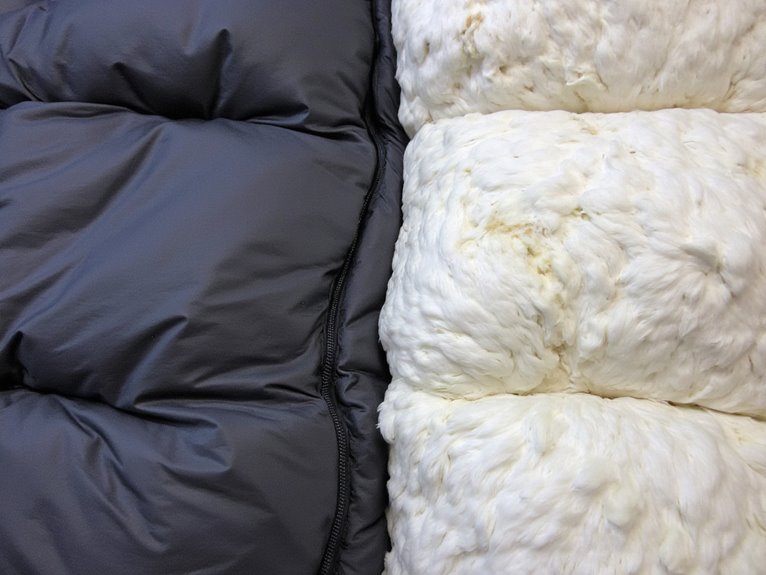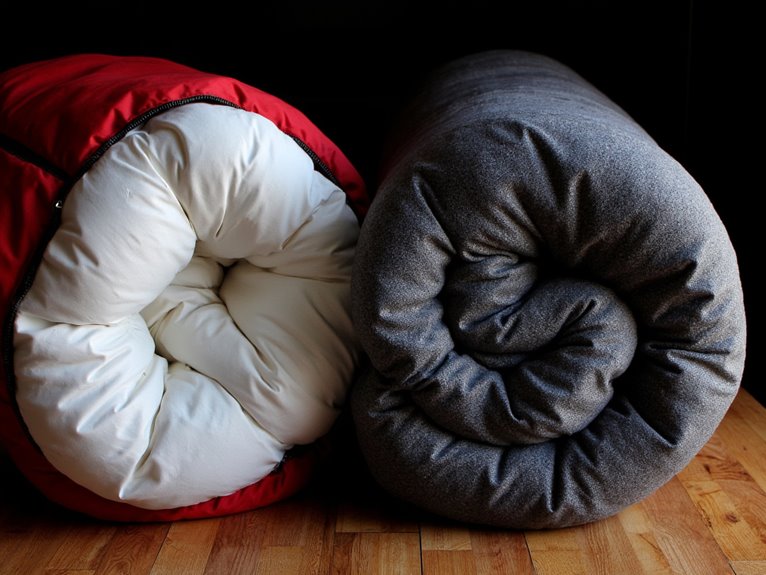How to Tell If Your Sleeping Bag Insulation Has Lost Loft
You’ll know your sleeping bag has lost loft when you see visible gaps or bald spots in the insulation, notice persistent flat areas that won’t bounce back after compression, or feel cold at temperatures that previously kept you comfortable. Check for clumping insulation, recovery failure when the bag won’t regain thickness, and a noticeably flatter appearance when tapped. These warning signs indicate compromised thermal performance that requires immediate attention or replacement to maintain your safety and comfort outdoors.
We are supported by our audience. When you purchase through links on our site, we may earn an affiliate commission, at no extra cost for you. Learn more. Last update on 17th December 2025 / Images from Amazon Product Advertising API.
Notable Insights
- Look for visible gaps or “bald spots” in the insulation that indicate uneven distribution and loft loss.
- Check if the sleeping bag fails to regain its original thickness after being compressed or stored.
- Notice if insulation clumps together, creating cold spots and reducing the bag’s thermal efficiency during use.
- Observe a noticeably flatter appearance when the bag is tapped, which suggests diminished loft and insulation breakdown.
- Experience persistent coldness at temperatures that were previously comfortable, indicating reduced thermal performance from loft loss.
Warning Signs Your Sleeping Bag Has Lost Its Loft
A sleeping bag that’s lost its insulating power won’t keep you warm, no matter how expensive it was when new.
Several warning signs indicate deteriorating loft performance that you can identify through visual inspection.
Visible gaps or “bald spots” appear when you shake out the bag, revealing uneven insulation distribution.
Shake your sleeping bag and watch for thin spots where insulation has shifted, creating uneven cold zones.
You’ll notice insulation clumps that stick together rather than separating freely. These clumps create cold spots during sleep, forcing you to add extra clothing layers.
Recovery failure becomes evident when your bag won’t regain thickness after compression, even following extended airing periods.
Persistent odor issues signal breakdown of insulation fibers and accumulated body oils.
The bag appears noticeably flatter and feels hollow when tapped, indicating permanent loft degradation requiring replacement.
Common Causes Behind Insulation Loft Loss

Understanding what damages your sleeping bag’s insulation helps you prevent costly loft loss and maintain thermal performance.
Three primary factors destroy insulation effectiveness: improper compression during storage, moisture exposure combined with dirt accumulation, and inevitable fiber degradation from regular use over time.
Each cause creates specific damage patterns that reduce your bag’s ability to trap warm air and maintain consistent temperature ratings.
Regular cleaning prevents insulation degradation and helps maintain the structural integrity of both down and synthetic fills when performed using proper techniques.
Compression and Storage Issues
Improper storage ranks as the leading cause of premature loft loss in sleeping bag insulation. Compression duration considerably impacts your bag’s thermal performance. Leaving your sleeping bag compressed in a stuff sack for months causes irreversible damage to insulation fibers. The storage conditions you choose determine your bag’s lifespan.
| Storage Method | Impact on Loft | Recommended Duration |
|---|---|---|
| Stuff Sack | High compression damage | Field use only |
| Breathable Storage Sack | Minimal loft loss | Long-term storage |
| Hanging/Loose | No compression damage | Ideal permanent storage |
Synthetic insulation loses loft faster than down under compression. Down typically recovers better after decompression cycles. Store your bag uncompressed in cool, dry conditions using breathable cotton or mesh storage sacks to maintain ideal lofting ability.
Moisture and Contamination Effects
While compression damages insulation mechanically, moisture and contamination attack your sleeping bag’s thermal performance through chemical and physical processes that prove even more destructive.
Moisture accumulation occurs through body perspiration, condensation from temperature gradients, and high ambient humidity. External wetness from rain or tent leaks compounds the problem.
Down clusters clump and collapse when wet, losing critical loft. Water conducts heat four times faster than dry fibers, greatly reducing insulation effectiveness. Even 3% moisture contamination by weight considerably impacts thermal performance.
Evaporative cooling adds approximately 3 watts of heat loss.
You’ll notice compressed appearance, cold spots, and musty odors. Visible clumping indicates moisture damage. After one week of exposure, water can reach 25% of fiber volume, severely compromising warmth retention and creating permanent loft reduction.
Natural Wear Over Time
Even without moisture exposure, your sleeping bag’s insulation faces inevitable deterioration through normal use and aging processes.
Natural degradation affects all sleeping bag materials, with synthetic insulation typically requiring replacement within 3-5 years while down maintains performance for over a decade with proper care.
Repeated compression from packing cycles gradually breaks down fiber structure.
Usage frequency accelerates this wear pattern, particularly when combined with poor storage conditions.
Your bag’s insulation lifespan depends heavily on maintenance practices and storage methods.
- Compression stress from frequent packing reduces insulation’s ability to trap air effectively
- Storage conditions like high humidity accelerate material breakdown over time
- Usage frequency determines how quickly fibers lose their structural integrity
- Material type affects degradation rates, with synthetics degrading faster than down
- Maintenance quality directly impacts how long insulation retains loft properties
How Insulation Type Affects Loft Degradation

The type of insulation in your sleeping bag fundamentally determines how loft degradation occurs and progresses over time.
Down Insulation and Synthetic Insulation degrade through completely different mechanisms. Down loses effectiveness primarily through clumping, where feather clusters stick together and lose their natural loft structure. Higher fill power down (700+ rating) demonstrates superior cling properties, maintaining insulating mass longer than lower quality alternatives.
Synthetic Insulation degrades through compression damage to individual fibers. Materials like Climashield Apex show minimal thermal performance loss under repeated compression cycles, while lower-grade synthetics degrade faster.
Synthetic insulation exhibits linear performance decline over time, potentially losing up to 20% loft with extensive use. Unlike down’s clumping, synthetic degradation affects fiber structure directly, making restoration more challenging despite some reversibility through proper washing techniques.
Hybrid insulation combines both materials and retains 80-90% loft in wet conditions compared to down’s 20-30%, offering a middle ground for loft retention characteristics.
Testing Methods to Measure Loft Loss
Understanding how loft degrades is only half the equation—you’ll need reliable methods to measure actual loft loss in your sleeping bag.
Professional testing standards like ASTM F1932-98 provide accurate loft measurement protocols using weighted plates and precise measuring tools.
Professional testing standards ensure precise loft measurements using standardized protocols with weighted plates and calibrated measuring instruments.
- Use a weighted plate with small lead weights to compress insulation without causing excessive damage.
- Measure loft near bag corners using precise instruments like Mitutoyo Digimatic calipers for consistency.
- Take measurements after recovery periods to assess how well your insulation bounces back from compression.
- Test in controlled environments to eliminate temperature and humidity variables that affect results.
- Compare current measurements against manufacturer specifications to calculate percentage of loft loss.
Each half-inch of loft reduction decreases temperature ratings by approximately 20°F, making accurate measurement critical for safety.
Maintenance Strategies to Preserve Insulation Loft

While measuring loft loss helps you assess your sleeping bag’s current condition, implementing proper maintenance strategies from day one will considerably extend its thermal performance and lifespan.
Store your bag uncompressed in breathable cotton or mesh sacks rather than stuff sacks. Temperature-controlled, dry environments prevent moisture buildup and insulation degradation. Avoid damp storage areas and direct sunlight exposure.
Effective cleaning practices involve washing once yearly with down-specific soap and lukewarm water. Hand washing prevents loft damage better than machine cycles.
Dry thoroughly on low heat with tennis balls to restore fill loft.
Master basic repair techniques immediately. Carry needle and thread for field repairs. Use adhesive gear tape with rounded corners for temporary shell patches.
Always sleep in clean baselayers to minimize oil transfer and preserve insulation quality.
High-quality down bags with proper care can maintain their loft and thermal efficiency for decades, with some lasting up to 10-50 years when maintenance protocols are consistently followed.
Deciding When to Replace Your Sleeping Bag
When should you retire your sleeping bag and invest in a replacement? Several clear indicators signal it’s time to upgrade your gear.
If you’re consistently cold despite proper layering, your insulation has likely degraded beyond recovery. Permanent flattening that doesn’t rebound after airing indicates structural breakdown. Most sleeping bags reach replacement time after 5-10 years, depending on usage frequency and storage conditions.
Your ideal replacement should match your specific outdoor conditions and usage patterns. Budget considerations include balancing initial cost against long-term performance needs. Women typically require bags rated 10-15 degrees warmer than standard models due to physiological differences in heat retention.
Key replacement indicators:
- Persistent coldness at previously comfortable temperatures
- Permanent insulation compression that won’t recover
- Age exceeding manufacturer’s recommended lifespan
- Irreparable structural damage like torn fabric or broken zippers
- Accelerated wear from harsh environmental exposure


